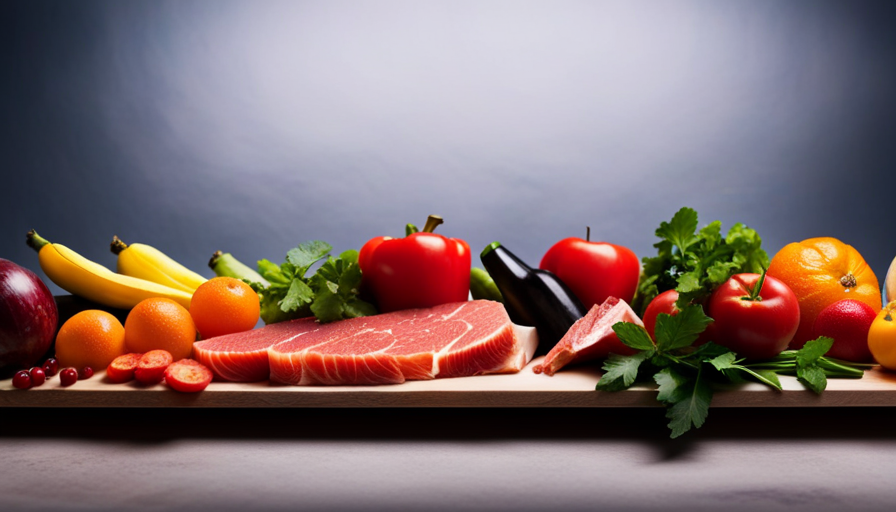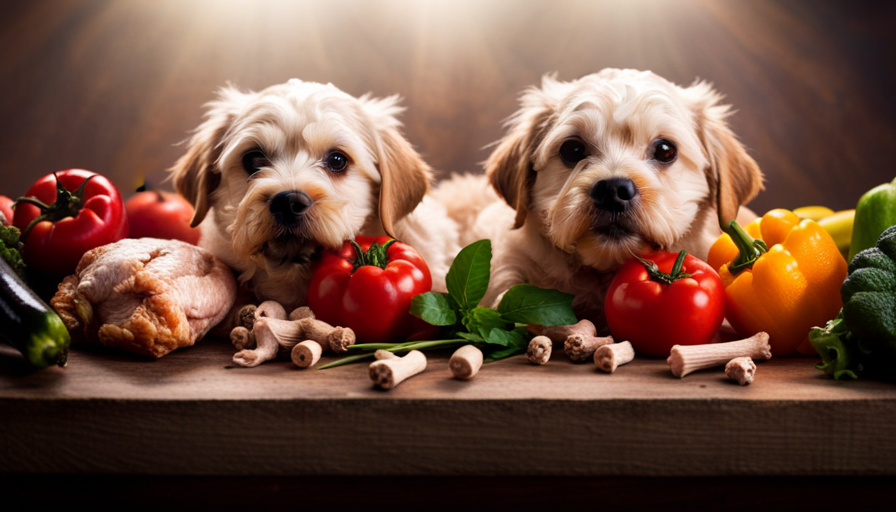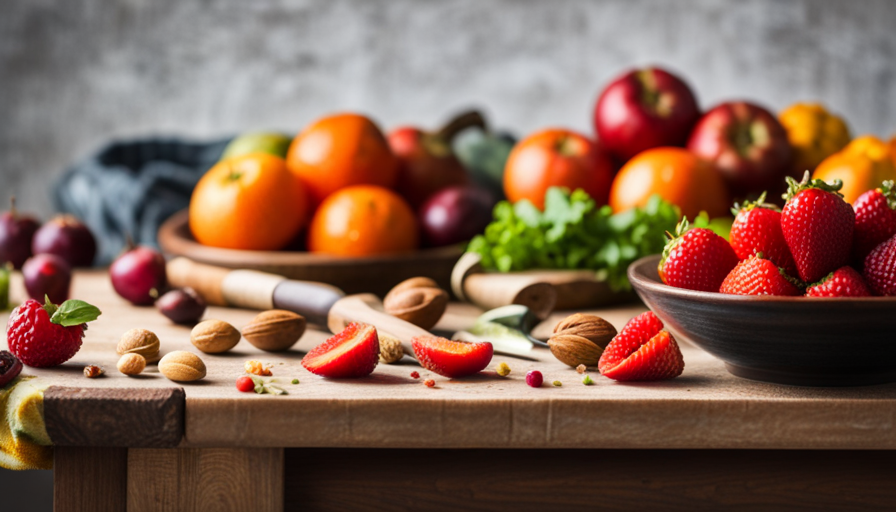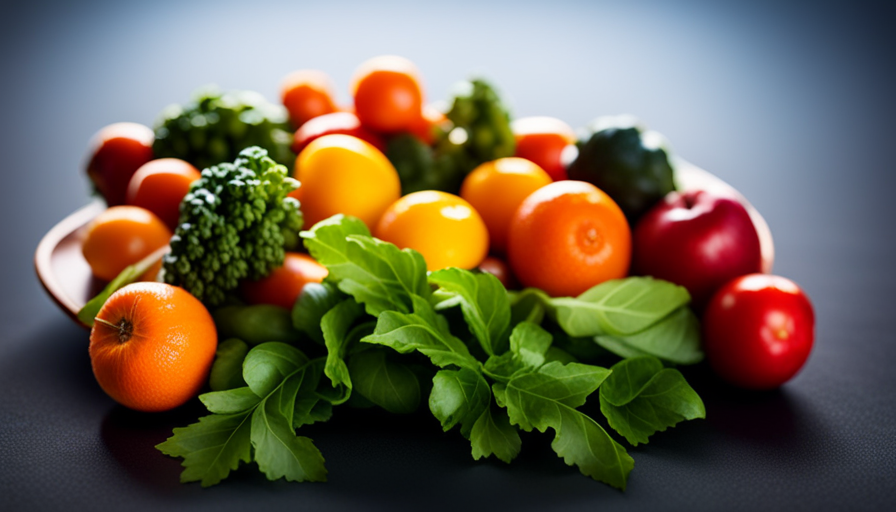Feeding our pets a raw food diet can be seen as a way to give them the best and most natural nutrition. As a caring pet owner, I recognize the significance of giving my furry companion a well-rounded and healthy diet. Nonetheless, figuring out the correct portion of raw food to give them may present some difficulties.
It’s crucial to strike the right balance to ensure their overall health and well-being. In this article, we will delve into the benefits of a raw food diet for pets and discuss how to determine the appropriate portion size. By understanding their nutritional needs, consulting with professionals, and monitoring their weight and energy levels, we can ensure that our beloved pets thrive on a raw food diet.
So let’s explore the ins and outs of feeding our pets raw food and provide them with a diet that supports their natural instincts and vitality.
Key Takeaways
- Transitioning to a raw food diet should be done gradually.
- Consultation with a veterinarian or pet nutritionist is recommended.
- Daily caloric requirements should be calculated for portion control.
- Portion sizes should be based on age, size, and activity level.
Benefits of a Raw Food Diet for Pets
Discover the incredible benefits of feeding your pets a raw food diet! Many pet owners have found that switching their pets to a raw food diet has numerous advantages. One of the main benefits is that it provides a more natural and species-appropriate diet for our furry friends. Raw food closely resembles what their ancestors would have eaten in the wild, which can lead to improved overall health and vitality.
However, it’s important to take certain precautions when feeding your pet a raw food diet. Raw food can potentially contain harmful bacteria such as Salmonella or E. coli. To ensure the safety of both your pet and your family, it’s essential to handle raw food with care. This includes practicing good hygiene, properly storing and handling raw food, and regularly cleaning your pet’s food and water bowls.
Transitioning your pet to a raw food diet should be done gradually to avoid any digestive upset. Start by introducing small amounts of raw food alongside their regular diet, and gradually increase the proportion of raw food over time. This gradual transition allows their digestive system to adjust and reduces the chances of any adverse reactions.
Understanding your pet’s nutritional needs is the next important step in providing a balanced raw food diet. Each animal has specific requirements, and it’s crucial to meet these needs through a variety of raw food sources. Consulting with a veterinarian or a pet nutritionist can help you design a raw food diet that meets all of your pet’s nutritional needs.
By feeding your pets a raw food diet, you can provide them with a more natural and species-appropriate diet, leading to improved health and vitality. However, it’s essential to follow raw food safety precautions and transition your pet gradually. Understanding your pet’s nutritional needs is also crucial in ensuring a balanced diet. With these considerations in mind, you can give your beloved pet the best possible care and nutrition.
Understanding Your Pet’s Nutritional Needs
Unveiling the depths of your furry friend’s dietary requirements can be a fascinating journey. Understanding your pet’s nutritional needs is crucial when considering a raw food diet.
Different pet species have varying nutritional requirements, and it’s essential to tailor their diet accordingly. For example, dogs require a balanced combination of protein, fats, and carbohydrates, while cats are obligate carnivores and need a higher proportion of animal-based protein.
To ensure that your pet receives the necessary nutrients from a raw food diet, it’s important to avoid common mistakes. Firstly, it’s crucial to provide a variety of protein sources to meet their amino acid requirements. Secondly, incorporating a proper amount of organ meat can supply essential vitamins and minerals. Lastly, including fruits and vegetables can provide additional nutrients and fiber.
By understanding the nutritional requirements for different pet species and avoiding common mistakes, you can ensure that your pet’s raw food diet is balanced and meets their needs. However, it’s always advisable to consult with a veterinarian or pet nutritionist to ensure that you’re providing the right amount and combination of nutrients for your furry friend’s optimal health.
Consult with a Veterinarian or Pet Nutritionist
Make sure to consult with a veterinarian or pet nutritionist to ensure that your furry friend is getting the right nutrients for their optimal health. Vet consultations are essential to understand your pet’s specific dietary needs and to receive tailored dietary recommendations. These professionals have the expertise to guide you in choosing the best raw food options and determining the appropriate portion sizes for your pet.
During a vet consultation, they will consider factors such as your pet’s age, breed, weight, activity level, and any specific health conditions they may have. This thorough evaluation allows them to provide you with accurate dietary recommendations that meet your pet’s individual needs.
To help you visualize the importance of these consultations, consider the following table:
| Benefits of Vet Consultations |
|---|
| 1. Personalized advice |
| 2. Addressing nutritional deficiencies |
| 3. Preventing overfeeding |
| 4. Managing specific health conditions |
| 5. Monitoring weight loss or gain |
Consulting with a veterinarian or pet nutritionist is crucial for your pet’s well-being. Once you have their dietary recommendations, you can proceed to calculate the daily caloric requirements for your pet, ensuring they receive the appropriate amount of food for their overall health and vitality.
Calculate the Daily Caloric Requirements for Your Pet
To ensure your furry friend stays healthy and energized, it’s important to calculate the daily caloric requirements tailored specifically for them.
This involves determining the amount of calories they need to consume each day to maintain their weight and overall well-being. To calculate the caloric intake, you can use a simple formula that takes into account your pet’s weight, age, activity level, and any underlying health conditions. It’s important to consult with a veterinarian or pet nutritionist to ensure accuracy in this calculation.
Portion control is another crucial aspect of feeding your pet a raw food diet. Once you have determined the daily caloric requirements, you can divide this into appropriate meal portions. It’s important to feed your pet multiple small meals throughout the day rather than one large meal to avoid overeating and digestive issues.
By calculating the daily caloric requirements and practicing portion control, you can ensure that your pet is getting the right amount of nutrients without overfeeding. This sets the foundation for a healthy and balanced raw food diet.
In the next section, we will explore how to determine the ideal ratio of protein, fat, and carbohydrates for your pet’s specific needs.
Determine the Ideal Ratio of Protein, Fat, and Carbohydrates
Figuring out the perfect balance of protein, fat, and carbohydrates for your furry friend can ensure they’re getting the nutrients they need to thrive.
When it comes to a raw food diet, protein is a crucial component. High-quality protein sources like lean meats, fish, and eggs provide essential amino acids that support muscle growth and repair. Including a variety of protein sources ensures your pet gets a wide range of nutrients.
In addition to protein, fat is an important energy source for your pet. Healthy fats from sources like salmon, coconut oil, and flaxseed provide essential fatty acids that support healthy skin and coat.
Carbohydrates, while not as essential for dogs and cats, can still be included in their diet. Opt for low-glycemic options like sweet potatoes, peas, and carrots.
To determine the ideal ratio of protein, fat, and carbohydrates, consult with a veterinarian or pet nutritionist. They can help tailor a raw food diet recipe that meets your pet’s specific needs. It’s important to consider your pet’s age, size, and activity level when determining their nutritional requirements. This will ensure they receive the right amount of nutrients to maintain optimal health.
Consider Your Pet’s Age, Size, and Activity Level
Take into account your pet’s age, size, and activity level when determining their nutritional needs, as a study conducted by the American Veterinary Medical Association found that the energy requirements of older dogs can be significantly lower than those of younger dogs. Feeding guidelines for raw food should consider these factors to ensure optimal health and well-being.
When it comes to meal planning, it is important to strike the right balance of protein, fat, and carbohydrates for your pet. A well-rounded diet should consist of approximately 50-60% muscle meat, 10% organ meat, 10% bone, and 20-30% fruits and vegetables. This provides the necessary nutrients for your pet’s overall health.
To help determine the appropriate amount of raw food to feed your pet, you can refer to the table below:
| Age | Size | Activity Level | Amount of Raw Food |
|---|---|---|---|
| Puppy | Small | Low | 2-3% of body weight |
| Adult | Medium | Moderate | 2-3% of body weight |
| Senior | Large | High | 1.5-2.5% of body weight |
These guidelines can serve as a starting point, but it is important to monitor your pet’s weight and adjust the portion sizes accordingly. Starting with small portions and monitoring your pet’s weight will help ensure that they are receiving the right amount of raw food for their individual needs.
Start with Small Portions and Monitor Your Pet’s Weight
Starting with small portions and keeping an eye on your pet’s weight will ensure they’re getting the perfect amount of nutrition. When transitioning your pet to a raw food diet, it’s important to establish a feeding schedule that works for both of you. This will help your pet adjust to their new diet and ensure they receive consistent meals throughout the day.
To determine the appropriate portion size, consider your pet’s age, size, and activity level. Puppies and active dogs may require more food compared to older or less active pets. It’s recommended to start with small portions and gradually increase the amount if needed. Monitoring your pet’s weight is crucial during this process. If you notice your pet gaining or losing weight, you may need to adjust the portion size accordingly.
There are various raw food recipes available that provide a balanced and nutritious diet for your pet. You can find recipes online or consult with a veterinarian or a pet nutritionist to create a customized meal plan. These recipes often include a combination of raw meat, bones, fruits, and vegetables to meet your pet’s nutritional needs.
In the next section, we’ll discuss how to adjust the portion size based on your pet’s health and energy levels. It’s important to consider these factors to ensure your pet remains healthy and maintains an optimal weight.
Adjust the Portion Size Based on Your Pet’s Health and Energy Levels
Keep a close eye on your furry companion’s vitality and physical condition so you can tailor the portion size to their specific needs, ensuring they stay in tip-top shape. Adjusting the portion size of your pet’s raw food diet based on their health and energy levels is crucial for their overall well-being. Just like with humans, every pet has different energy requirements, so it’s essential to monitor their energy levels and adjust their portion size accordingly.
To help you understand the relationship between portion size and energy levels, here is a table that provides a general guideline:
| Energy Level | Portion Size |
|---|---|
| Low | Small |
| Moderate | Medium |
| High | Large |
| Very High | Extra Large |
By observing your pet’s energy levels, you can determine whether they need more or less food. If your pet is lethargic or gaining weight, you may need to decrease their portion size. On the other hand, if they are highly active or losing weight, increasing their portion size may be necessary.
In the next section, we will explore the importance of incorporating variety in your pet’s raw food diet to ensure they receive all the necessary nutrients.
Incorporate Variety in Your Pet’s Raw Food Diet
To ensure your furry friend gets a well-rounded and exciting diet, add a variety of ingredients to their raw meal plan. Meal planning is essential when it comes to feeding your pet a raw food diet. It’s important to introduce new ingredients gradually and observe how your pet reacts to them. This will help you identify any potential allergies or sensitivities.
When incorporating variety into your pet’s raw food diet, remember to include a mix of proteins, such as chicken, beef, and fish. This ensures they receive a balanced amount of essential nutrients. Additionally, don’t forget to include a variety of fruits and vegetables, like carrots, apples, and spinach, to provide important vitamins and minerals.
Introducing new ingredients can be done by gradually substituting a small portion of your pet’s regular meal with the new ingredient. This allows their digestive system to adjust and prevents any digestive upsets. It’s also a good idea to consult with your veterinarian or a pet nutritionist to ensure you’re providing a well-balanced diet.
By incorporating variety in your pet’s raw food diet, you not only keep them interested in their meals but also provide them with a range of nutrients. Observing your pet’s overall health and well-being is crucial in determining the success of their raw food diet.
Observe Your Pet’s Overall Health and Well-being
When it comes to incorporating variety into your pet’s raw food diet, it’s important to also observe their overall health and well-being. As a pet owner, I’ve found that paying attention to my pet’s behavior and any changes in their dietary habits can provide valuable insights into their nutritional needs.
One of the key indicators of a well-balanced raw food diet is your pet’s behavior. Are they energetic and playful? Do they have a shiny coat and healthy skin? These are signs that your pet is thriving on their current diet. However, if you notice any changes in their behavior, such as lethargy or a decrease in appetite, it may be a signal that adjustments need to be made.
Dietary changes can be necessary for a variety of reasons. For example, if your pet is experiencing digestive issues or allergies, you may need to eliminate certain ingredients from their diet. On the other hand, if you want to introduce new proteins or add more variety to their meals, it should be done gradually to avoid any digestive upset.
Remember, every pet is unique, and their nutritional needs may vary. By observing your pet’s behavior and making necessary adjustments to their raw food diet, you can ensure that they’re getting the right balance of nutrients for optimal health and well-being.
Frequently Asked Questions
Can I feed my pet a raw food diet if they have specific dietary restrictions or allergies?
Yes, it’s possible to feed your pet a raw food diet even if they have specific dietary restrictions or allergies. However, it’s important to consult with a veterinarian or a veterinary nutritionist before making any changes to your pet’s diet. Raw food recipes can be tailored to meet your pet’s specific needs, and some pet owners find that a raw food diet can help alleviate allergies or dietary sensitivities. It’s also important to consider the potential risks associated with raw food, such as bacterial contamination, and weigh the benefits against the potential drawbacks.
How do I ensure my pet is getting all the necessary nutrients on a raw food diet?
Ensuring proper nutrition on a raw food diet is essential for pets, including senior ones. To achieve this, I recommend consulting with a veterinarian or a veterinary nutritionist. They can help create a balanced meal plan tailored to your pet’s specific needs.
It’s important to include a variety of protein sources, such as lean meats and organ meats, along with fruits, vegetables, and supplements to ensure your pet gets all the necessary nutrients. Regular monitoring and adjustments may be necessary to optimize your pet’s health.
What are the potential risks or drawbacks of feeding my pet a raw food diet?
Feeding my pet a raw food diet has its potential health risks and concerns. One of the main concerns is the risk of bacterial contamination, which can lead to foodborne illnesses.
Another concern is the imbalance of nutrients, as it can be challenging to ensure that my pet is getting all the necessary vitamins and minerals in the right proportions.
Additionally, feeding raw food can increase the risk of choking or dental issues.
It’s important to weigh the benefits and risks before making this dietary choice.
Can I feed my pet a combination of raw and commercial pet food?
Yes, you can feed your pet a combination of raw and commercial pet food. This can be a good option if your pet has dietary restrictions or allergies. It allows you to provide a varied and balanced diet. However, it’s important to consult with your veterinarian to ensure that you’re meeting your pet’s specific nutritional needs. They can help you determine the right proportions and guide you on any necessary supplements to ensure your pet’s health and well-being.
How should I properly store and handle raw food for my pet to prevent foodborne illnesses?
Properly storing and handling raw pet food is crucial for preventing foodborne illnesses. It’s important to keep raw food separate from human food. Store it in the refrigerator or freezer to maintain freshness and prevent bacterial growth. Thaw frozen raw food in the refrigerator. Clean all surfaces and utensils used to handle raw food.
It’s also essential to address common misconceptions about raw food diets for pets. For example, some believe that these diets provide all necessary nutrients. However, it’s best to consult a veterinarian for guidance on a balanced diet for your pet.
What Should I Expect When Transitioning My Pet to a Raw Food Diet and How Much Should I Feed Them?
When transitioning your pet to a raw food diet, it is important to have realistic raw food diet expectations. Initially, your pet may experience digestive upset, but this should improve over time. Start with smaller portions and gradually increase the amount to avoid overfeeding. Monitoring their weight and overall health is crucial.
Conclusion
In conclusion, feeding your pet a raw food diet can be a beneficial choice for their overall health and well-being. Just like how a fresh garden salad nourishes us, raw food provides essential nutrients for our furry friends.
However, it’s crucial to consult with a veterinarian or pet nutritionist to determine the right amount of food to feed. By calculating their daily caloric requirements and adjusting portion sizes accordingly, we can ensure that our pets maintain a healthy weight and energy levels.
Remember to observe their overall health and make adjustments as needed.










